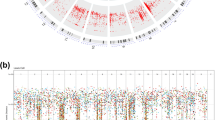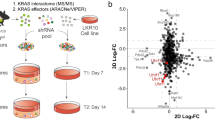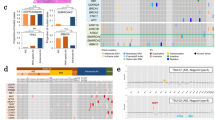Abstract
In an effort to identify novel biallelically inactivated tumor suppressor genes (TSGs) in sporadic invasive and preinvasive non-small-cell lung cancer (NSCLC) genomes, we applied a comprehensive integrated multiple ‘omics’ approach to investigate patient-matched, paired NSCLC tumor and non-malignant parenchymal tissues. By surveying lung tumor genomes for genes concomitantly inactivated within individual tumors by multiple mechanisms, and by the frequency of disruption in tumors across multiple cohorts, we have identified a putative lung cancer TSG, Eyes Absent 4 (EYA4). EYA4 is frequently and concomitantly deleted, hypermethylated and underexpressed in multiple independent lung tumor data sets, in both major NSCLC subtypes and in the earliest stages of lung cancer. We found that decreased EYA4 expression is not only associated with poor survival in sporadic lung cancers but also that EYA4 single-nucleotide polymorphisms are associated with increased familial cancer risk, consistent with EYA4s proximity to the previously reported lung cancer susceptibility locus on 6q. Functionally, we found that EYA4 displays TSG-like properties with a role in modulating apoptosis and DNA repair. Cross-examination of EYA4 expression across multiple tumor types suggests a cell-type-specific tumorigenic role for EYA4, consistent with a tumor suppressor function in cancers of epithelial origin. This work shows a clear role for EYA4 as a putative TSG in NSCLC.
This is a preview of subscription content, access via your institution
Access options
Subscribe to this journal
Receive 50 print issues and online access
$259.00 per year
only $5.18 per issue
Buy this article
- Purchase on Springer Link
- Instant access to full article PDF
Prices may be subject to local taxes which are calculated during checkout







Similar content being viewed by others
References
Lozano R, Naghavi M, Foreman K, Lim S, Shibuya K, Aboyans V et al. Global and regional mortality from 235 causes of death for 20 age groups in 1990 and 2010: a systematic analysis for the Global Burden of Disease Study 2010. Lancet 2012; 380: 2095–2128.
Jemal A, Bray F, Center MM, Ferlay J, Ward E, Forman D . Global cancer statistics. Cancer J Clin 2011; 61: 69–90.
Knudson AG Jr. . Mutation and cancer: statistical study of retinoblastoma. Proc Natl Acad Sci USA 1971; 68: 820–823.
Nagayama K, Kohno T, Sato M, Arai Y, Minna JD, Yokota J . Homozygous deletion scanning of the lung cancer genome at a 100-kb resolution. Genes Chromosomes Cancer 2007; 46: 1000–1010.
Selamat SA, Galler JS, Joshi AD, Fyfe MN, Campan M, Siegmund KD et al. DNA methylation changes in atypical adenomatous hyperplasia, adenocarcinoma in situ, and lung adenocarcinoma. PLoS One 2011; 6: e21443.
Osborn NK, Zou H, Molina JR, Lesche R, Lewin J, Lofton-Day C et al. Aberrant methylation of the eyes absent 4 gene in ulcerative colitis-associated dysplasia. Clin Gastroenterol Hepatol 2006; 4: 212–218.
Oster B, Thorsen K, Lamy P, Wojdacz TK, Hansen LL, Birkenkamp-Demtroder K et al. Identification and validation of highly frequent CpG island hypermethylation in colorectal adenomas and carcinomas. Int J Cancer 2011; 129: 2855–2866.
Kim YH, Lee HC, Kim SY, Yeom YI, Ryu KJ, Min BH et al. Epigenomic analysis of aberrantly methylated genes in colorectal cancer identifies genes commonly affected by epigenetic alterations. Ann Surg Oncol 2011; 18: 2338–2347.
Kisiel JB, Yab TC, Taylor WR, Chari ST, Petersen GM, Mahoney DW et al. Stool DNA testing for the detection of pancreatic cancer: assessment of methylation marker candidates. Cancer 2012; 118: 2623–2631.
Thu KL, Radulovich N, Becker-Santos DD, Pikor LA, Pusic A, Lockwood WW et al. SOX15 is a candidate tumor suppressor in pancreatic cancer with a potential role in Wnt/beta-catenin signaling. Oncogene 2013; 32: 279–288.
Hammerman PS, Hayes DN, Wilkerson MD, Schultz N, Bose R, Chu A et al. Comprehensive genomic characterization of squamous cell lung cancers. Nature 2012; 489: 519–525.
Thu KL, Vucic EA, Chari R, Zhang W, Lockwood WW, English JC et al. Lung adenocarcinoma of never smokers and smokers harbor differential regions of genetic alteration and exhibit different levels of genomic instability. PLoS One 2012; 7: e33003.
Weir BA, Woo MS, Getz G, Perner S, Ding L, Beroukhim R et al. Characterizing the cancer genome in lung adenocarcinoma. Nature 2007; 450: 893–898.
Chitale D, Gong Y, Taylor BS, Broderick S, Brennan C, Somwar R et al. An integrated genomic analysis of lung cancer reveals loss of DUSP4 in EGFR-mutant tumors. Oncogene 2009; 28: 2773–2783.
Weiss J, Sos ML, Seidel D, Peifer M, Zander T, Heuckmann JM et al. Frequent and focal FGFR1 amplification associates with therapeutically tractable FGFR1 dependency in squamous cell lung cancer. Sci Transl Med 2010; 2: 62ra93.
Bild AH, Yao G, Chang JT, Wang Q, Potti A, Chasse D et al. Oncogenic pathway signatures in human cancers as a guide to targeted therapies. Nature 2006; 439: 353–357.
Landi MT, Dracheva T, Rotunno M, Figueroa JD, Liu H, Dasgupta A et al. Gene expression signature of cigarette smoking and its role in lung adenocarcinoma development and survival. PLoS One 2008; 3: e1651.
Thusberg J, Olatubosun A, Vihinen M . Performance of mutation pathogenicity prediction methods on missense variants. Hum Mutat 2011; 32: 358–368.
Lonergan KM, Chari R, Coe BP, Wilson IM, Tsao MS, Ng RT et al. Transcriptome profiles of carcinoma-in-situ and invasive non-small cell lung cancer as revealed by SAGE. PLoS One 2010; 5: e9162.
Chen Z, Trotman LC, Shaffer D, Lin HK, Dotan ZA, Niki M et al. Crucial role of p53-dependent cellular senescence in suppression of Pten-deficient tumorigenesis. Nature 2005; 436: 725–730.
Sadatomi D, Tanimura S, Ozaki K, Takeda K . Atypical protein phosphatases: emerging players in cellular signaling. Int J Mol Sci 2013; 14: 4596–4612.
Okabe Y, Sano T, Nagata S . Regulation of the innate immune response by threonine-phosphatase of Eyes absent. Nature 2009; 460: 520–524.
MacPhail SH, Banath JP, Yu TY, Chu EH, Lambur H, Olive PL . Expression of phosphorylated histone H2AX in cultured cell lines following exposure to X-rays. Int J Radiat biology 2003; 79: 351–358.
Pignoni F, Hu B, Zavitz KH, Xiao J, Garrity PA, Zipursky SL . The eye-specification proteins So and Eya form a complex and regulate multiple steps in Drosophila eye development. Cell 1997; 91: 881–891.
Clark SW, Fee BE, Cleveland JL . Misexpression of the eyes absent family triggers the apoptotic program. J Biol Chem 2002; 277: 3560–3567.
Liu X, Sano T, Guan Y, Nagata S, Hoffmann JA, Fukuyama H . Drosophila EYA regulates the immune response against DNA through an evolutionarily conserved threonine phosphatase motif. PLoS One 2012; 7: e42725.
De Carvalho DD, Sharma S, You JS, Su SF, Taberlay PC, Kelly TK et al. DNA methylation screening identifies driver epigenetic events of cancer cell survival. Cancer Cell 2012; 21: 655–667.
Zou H, Osborn NK, Harrington JJ, Klatt KK, Molina JR, Burgart LJ et al. Frequent methylation of eyes absent 4 gene in Barrett's esophagus and esophageal adenocarcinoma. Cancer Epidemiol Biomarkers Prev 2005; 14: 830–834.
Tusher VG, Tibshirani R, Chu G . Significance analysis of microarrays applied to the ionizing radiation response. Proc Natl Acad Sci USA 2001; 98: 5116–5121.
Zhang X, Sun H, Danila DC, Johnson SR, Zhou Y, Swearingen B et al. Loss of expression of GADD45 gamma, a growth inhibitory gene, in human pituitary adenomas: implications for tumorigenesis. J Clin Endocrinol Metab 2002; 87: 1262–1267.
Miller SJ, Lan ZD, Hardiman A, Wu J, Kordich JJ, Patmore DM et al. Inhibition of Eyes Absent Homolog 4 expression induces malignant peripheral nerve sheath tumor necrosis. Oncogene 2010; 29: 368–379.
Boelens MC, van den Berg A, Fehrmann RS, Geerlings M, de Jong WK, te Meerman GJ et al. Current smoking-specific gene expression signature in normal bronchial epithelium is enhanced in squamous cell lung cancer. J Pathol 2009; 218: 182–191.
You M, Wang D, Liu P, Vikis H, James M, Lu Y et al. Fine mapping of chromosome 6q23–25 region in familial lung cancer families reveals RGS17 as a likely candidate gene. Clin Cancer Res 2009; 15: 2666–2674.
Bailey-Wilson JE, Amos CI, Pinney SM, Petersen GM, de Andrade M, Wiest JS et al. A major lung cancer susceptibility locus maps to chromosome 6q23–25. Am J Hum Genet 2004; 75: 460–474.
Amos CI, Pinney SM, Li Y, Kupert E, Lee J, de Andrade MA et al. A susceptibility locus on chromosome 6q greatly increases lung cancer risk among light and never smokers. Cancer Res 2010; 70: 2359–2367.
Selamat SA, Chung BS, Girard L, Zhang W, Zhang Y, Campan M et al. Genome-scale analysis of DNA methylation in lung adenocarcinoma and integration with mRNA expression. Genome Res 2012; 22: 1197–1211.
Kisiel JB, Yab TC, Nazer Hussain FT, Taylor WR, Garrity-Park MM, Sandborn WJ et al. Stool DNA testing for the detection of colorectal neoplasia in patients with inflammatory bowel disease. Aliment Pharmacol Therap 2013; 37: 546–554.
Sellers TA, Bailey-Wilson JE, Elston RC, Wilson AF, Elston GZ, Ooi WL et al. Evidence for Mendelian inheritance in the pathogenesis of lung cancer. J Natl Cancer Instit 1990; 82: 1272–1279.
Sellers TA, Potter JD, Bailey-Wilson JE, Rich SS, Rothschild H, Elston RC . Lung cancer detection and prevention: evidence for an interaction between smoking and genetic predisposition. Cancer Res 1992; 52 (Suppl): 2694s–2697ss.
Tokuhata GK, Lilienfeld AM . Familial aggregation of lung cancer in humans. J Natl Cancer Inst 1963; 30: 289–312.
Tessema M, Willink R, Do K, Yu YY, Yu W, Machida EO et al. Promoter methylation of genes in and around the candidate lung cancer susceptibility locus 6q23–25. Cancer Res 2008; 68: 1707–1714.
Bell DW, Erban J, Sgroi DC, Haber DA . Selective loss of heterozygosity in multiple breast cancers from a carrier of mutations in both BRCA1 and BRCA2. Cancer Res 2002; 62: 2741–2743.
Bijron JG, van der Groep P, van Dorst EB, Seeber LM, Sie-Go DM, Verheijen RH et al. Promoter hypermethylation patterns in Fallopian tube epithelium of BRCA1 and BRCA2 germline mutation carriers. Endocr Relat Cancer 2011; 19: 69–81.
Birgisdottir V, Stefansson OA, Bodvarsdottir SK, Hilmarsdottir H, Jonasson JG, Eyfjord JE . Epigenetic silencing and deletion of the BRCA1 gene in sporadic breast cancer. Breast Cancer Res 2006; 8: R38.
Bibikova M, Le J, Barnes B, Saedinia-Melnyk S, Zhou L, Shen R et al. Genome-wide DNA methylation profiling using Infinium(R) assay. Epigenomics 2009; 1: 177–200.
Cancer Genome Atlas Research Network. Comprehensive genomic characterization of squamous cell lung cancers. Nature 2012; 489: 519–525.
Barrett T, Troup DB, Wilhite SE, Ledoux P, Rudnev D, Evangelista C et al. NCBI GEO: archive for high-throughput functional genomic data. Nucleic Acids Res 2009; 37: D885–D890.
Irizarry RA, Hobbs B, Collin F, Beazer-Barclay YD, Antonellis KJ, Scherf U et al. Exploration, normalization, and summaries of high density oligonucleotide array probe level data. Biostatistics 2003; 4: 249–264.
Gentleman RC, Carey VJ, Bates DM, Bolstad B, Dettling M, Dudoit S et al. Bioconductor: open software development for computational biology and bioinformatics. Genome Biol 2004; 5: R80.
Liu P, Vikis HG, Wang D, Lu Y, Wang Y, Schwartz AG et al. Familial aggregation of common sequence variants on 15q24–25.1 in lung cancer. J Natl Cancer Inst 2008; 100: 1326–1330.
Thu KL, Pikor LA, Chari R, Wilson IM, Macaulay CE, English JC et al. Genetic disruption of KEAP1/CUL3 E3 ubiquitin ligase complex components is a key mechanism of NF-kappaB pathway activation in lung cancer. J Thorac Oncol 2011. 1521–1529.
Coe BP, Chari R, MacAulay C, Lam WL . FACADE: a fast and sensitive algorithm for the segmentation and calling of high resolution array CGH data. Nucleic Acids Res 2010; 38: e157.
Lockwood WW, Wilson IM, Coe BP, Chari R, Pikor LA, Thu KL et al. Divergent genomic and epigenomic landscapes of lung cancer subtypes underscore the selection of different oncogenic pathways during tumor development. PLoS One 2012; 7: e37775.
Olive PL, Banath JP . Phosphorylation of histone H2AX as a measure of radiosensitivity. Int J Radiat Oncol Biol Phys 2004; 58: 331–335.
Acknowledgements
We thank Miwa Suzuki, Denise McDougal, Chad Malloff and Bradley Coe for assistance. Grant supports were from Canadian Institutes of Health Research (CIHR MOP86731, MOP77903, MOP94867), Canadian Cancer Society (CCS017076, CCS20485); Terry Fox Foundation (20395); NCI Early Detection Research Network (5U01 CA84971-10), Canary Foundation, NIH Genetic Epidemiology of Lung Cancer Consortium (U01CA76293); and scholarships from CIHR (IMW, EAV, KSSE and WWL) and Vanier Canada (RC, KLT and NR).
Author information
Authors and Affiliations
Corresponding author
Ethics declarations
Competing interests
The authors declare no conflict of interest.
Additional information
Supplementary Information accompanies this paper on the Oncogene website
Supplementary information
Rights and permissions
About this article
Cite this article
Wilson, I., Vucic, E., Enfield, K. et al. EYA4 is inactivated biallelically at a high frequency in sporadic lung cancer and is associated with familial lung cancer risk. Oncogene 33, 4464–4473 (2014). https://doi.org/10.1038/onc.2013.396
Received:
Revised:
Accepted:
Published:
Issue Date:
DOI: https://doi.org/10.1038/onc.2013.396
Keywords
This article is cited by
-
EYA4 promotes breast cancer progression and metastasis through its role in replication stress avoidance
Molecular Cancer (2023)
-
The value of EYA1/3/4 in clear cell renal cell carcinoma: a study from multiple databases
Scientific Reports (2023)
-
Circular RNA ACVR2A suppresses bladder cancer cells proliferation and metastasis through miR-626/EYA4 axis
Molecular Cancer (2019)
-
EYA4 gene functions as a prognostic marker and inhibits the growth of intrahepatic cholangiocarcinoma
Chinese Journal of Cancer (2016)



